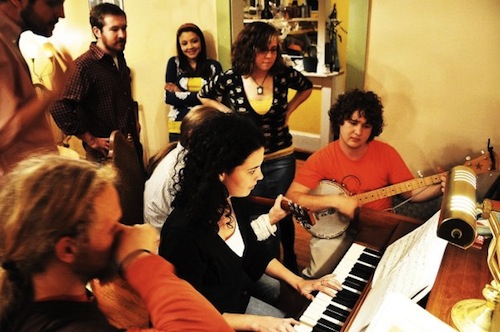I taught high school my first three years out of college, and it was a perfect combination of order and chaos. I spent hours making lesson plans, reading, grading, giving feedback on work, planning down to the letter how each day would go. Of course, after taking the first step into my classroom, my grip on those plans was significantly loosened by my dear students. Sometimes they needed me to guide them in a different direction with the lesson material, sometimes they looked to each other for distraction. Sometimes they even broke out in unmerited applause and cheers for me, for no other reason than to watch me stand at the front of the room and laugh while being confused. They were usually the cause of delightful chaos.
We often associate order with boredom and chaos with disaster, but I’ve been able to see beauty when the two are blended.
I noticed this during a flight to New York City in February. We waited to take off. I heard the rumble of the wheels on the runway and the whistle of the fans picking up pitch with speed until my stomach turned a light flip as the plane rose above a ribbon of russet-colored concrete that cut straight through the trees. The plane hovered close enough for me to see the different heights of the pines, the barren limbs of the deciduous trees scattered in patches, and the lopsided, indefinite shapes of lakes and ponds. Then I saw a rigid line of houses, all the same shape, all leading to and then gathering around a cul-de-sac, like the spokes of a bicycle wheel. Each had a precise, square-cut yard of bright green, as if someone laid an iron grid and told the grass to grow. I glanced up to see a single cumulus cloud, close. No defined shape, only layers upon layers of water droplets catching the sun’s light, dense with thinning edges.
Seeing all of this, I thought of the roles of photosynthesis in a leaf on a tree, of the turnover in a lake, of the water cycle of a cloud. These processes follow explicit natural order, yet the hosts themselves looked unrefined with their mismatched sizes and ragged borders.
These habitats of nature were different from the inner workings of those perfectly aligned houses. No, I couldn’t tell you who lived there or what daily activities those people pursued. But as I have come to learn being away from teaching for a short four years, life is messy. Even within our safe routines.
I’ve always been partial to structure. When I graduated from college, I took that full-time teaching job for a secure income and for work that filled the majority of my day. During the first month of my new job, I moved into a new house with new roommates, my pastor at the church where I was serving as a worship leader resigned, and my grandfather died. Nearly every major life change — job, moving, death — had come at me in four weeks’ time. Chaos had shattered the facade of security I thought I found in structure.
But it was in that time of uncertainty at every corner that I learned to lean on my friends and share in their havoc as well. One friend’s parents were separating. Another friend was preparing to move to New Orleans. And all of us were floundering, together trying to figure out life without the guide of classes, evaluations, and feedback from instructors. The only life we had ever known was one with order and expectations. After graduation, the world was ours with which to reckon. More than we expected, I bet.
I also learned that while I had my routine, I couldn’t depend on it. And thinking deeper on the subject, I didn’t want to. Something within us — though we seek to give an impression of total control — wants an adventure. I’m beginning to understand that this adventure we end up experiencing is different from the one we seek in childhood or in our youth as twenty-somethings. It is not solely world travel, fame, or even the chase of seemingly impossible dreams. The adventure is in community, in sharing life together, and in the natural chaos it brings.
 Photo: Jay Grant
Photo: Jay Grant
Just when I thought I was getting settled after three years of teaching, the school made some cuts, and I was out of a job. Once again, I was thrown into the unknown, but I knew despite the angst and worry that I would be provided for. My husband was working, patient, supportive. Our friends kept an eye out for job openings. Now I’m working for a one-hundred-year-old Presbyterian church downtown and also for a bow tie business. I’ve been amazed at how the speed of life has seemed to pick up since taking these simpler jobs. Our community flourishes in such a way now that the grading and preparation of a teaching job would not allow me to fully serve otherwise. We invite friends over for dinner during the week and throw neighborhood parties at our house during the weekend. I’m still taking part in investing in others’ lives as I did while teaching, just in a neighborly way in addition to my other work. It’s a beautiful ebb and flow of excitement in the ordinary happenings of life, and I’m thankful for the wisdom I’ve gained through holding loosely to order and embracing the chaos.
Erica Crotts works as an administrative assistant with a downtown church and a bow tie business. She is involved in Friday Arts Project, a local affiliate of International Arts Movement. Erica and her illustrator-husband, Stephen, live in a red bungalow near Winthrop University in Old Town Rock Hill, South Carolina. Together, they enjoy working their garden, playing music, baking, and spending much of their time with dear friends and neighbors.














